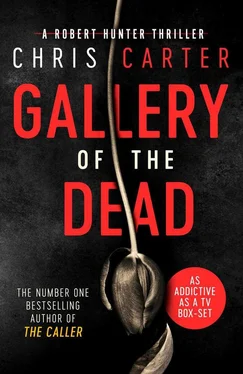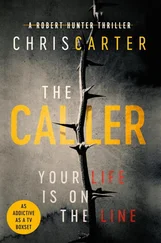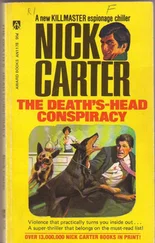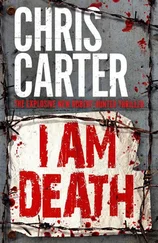‘And you’re not alone in your reaction either,’ Garcia added. ‘It happened to all of us at the crime scene. As soon as we discovered the cat in the freezer, everyone’s mood took a turn, even Robert’s, and you know how calm and collected he always is.’
Captain Blake kept her eyes on the picture for just another second before turning away in disgust. ‘It takes a different kind of “sick” to mutilate and skin a body in the way that it was done here, but to do something like this to a tiny animal, who would’ve posed absolutely no threat whatsoever—’
‘It’s shocking, but not surprising,’ Hunter interrupted.
She glared at him.
‘Many psychopaths start to show signs of psychopathy at a very young age,’ Hunter reminded her. ‘Cruelty to animals and predisposition for arson are the two top items on that “early signs of psychopathy” list. Many modern serial killers have graduated from hurting and killing animals to hurting and killing people. It’s a fact. So yes, this is shocking, but not surprising.’
‘So what you’re telling me here is that we are probably dealing with a completely emotionless freak. Someone whose level of emotional detachment toward life in general is off the scale — human... animal... it doesn’t matter because he couldn’t care less.’
‘I have no doubt of that, Captain,’ Garcia replied.
‘There’s another possibility,’ Hunter said, but before he was able to explain, the phone on his desk rang.
Before sharing the results of Linda Parker’s post-mortem examination with Hunter and Garcia, Dr. Hove decided to once again go over a couple of her findings, just to be absolutely sure. Thirty-five minutes later, still sitting inside Autopsy Theater Zero, she finally called the detectives at the Police Administration Building.
‘Robert, it’s Carolyn Hove,’ she said as Hunter picked up the phone at the other end. ‘I’m done with the Level Zero autopsy you’ve requested.’
‘Oh, that’s great, Doc,’ Hunter said. ‘So what have you got for us?’
Dr. Hove’s stare wandered back to the body on the examination table. The familiar Y incision that ran from the top of each shoulder to the lower part of the sternum had already been sewn shut. Thick black stitches now ran the entire length of the cut, adding a whole new layer of grotesqueness to an already alien-looking body.
‘Something quite intriguing, I must say,’ she replied.
Hunter paused for a second. ‘Give me a moment, Doc. Let me put you on speakerphone...’
Dr. Hove heard a muffled click come through on her earpiece before Hunter spoke again.
‘OK, Doc. Go ahead.’
‘Well,’ she began. ‘Given the mutilated state the body is in and the gravity of its wounds, I was expecting to find that the victim had been severely tortured prior to her death, but that isn’t the case at all.’
‘How do you mean?’ The question was asked by a somewhat distant female voice, which made Dr. Hove frown.
‘Sorry, who is this?’ she asked with concern.
‘Sorry, Carolyn, it’s Barbara Blake.’ Her voice strengthened as the captain stepped closer to Hunter’s desk. ‘I should’ve said hello when Robert placed the call on speakerphone.’
‘Oh no, not at all. Sorry I didn’t recognize your voice, Barbara. It sounded a little distant. How are you doing, anyway?’
‘Not too bad, but something tells me that that’s about to change.’
‘Just to avoid any more surprises,’ Dr. Hove said, ‘whom else am I speaking to?’
‘Just me, Doc,’ Garcia called out. ‘It’s just the three of us in here.’
‘Carolyn, what did you mean when you said that that wasn’t the case?’ Captain Blake asked again.
‘Well, as we all know, appearances can be quite deceiving, and that indeed is the case here, because despite how violent this murder looks to have been, the victim didn’t suffer.’
Dr. Hove’s announcement was met by an awkward silence from the other end of the line. In her mind, she could picture the stare that Hunter, Garcia and Captain Blake would be exchanging between them.
‘She didn’t suffer?’ Captain Blake asked at last, her voice coated with doubt.
‘Nope. Not according to what I found out. All the barbarism that was done to her — the skinning of the body, the amputation of the hands and feet — it was all done post-mortem.’
There was another long, uneasy silence before Garcia asked the next question.
‘So the victim didn’t bleed to death from her wounds?’
‘No. She died of asphyxiation. And here comes another surprise — the asphyxiation was done by suffocation, not strangulation.’
‘Hold on, Doc,’ Garcia said. ‘Can you please run that by me again?’
‘The muscles on her neck show no bruising,’ Dr. Hove explained. ‘Her larynx and trachea aren’t crushed and the hyoid bone isn’t fractured. Actually, I found no damage whatsoever to her neck, throat, or her respiratory system.’
‘So how did she suffocate?’ This time the question came from Captain Blake. ‘The killer put a pillow over her face while she slept?’
‘Something like that,’ the doctor replied. ‘But it wasn’t a pillow, Barbara. When the body senses it’s asphyxiating, its automatic physiological response is to try to draw in the deepest breath it possibly can. As it realizes that that breath is lacking in oxygen, it panics and instantly tries again. This time, a lot more desperately, I should add. A pillow, a gag, a shirt... anything made out of any sort of textile fabrics would release fibers, which, with the victim’s frantic deep breaths, would’ve been sucked into her mouth and nostrils and lodged themselves all over the place.’ Dr. Hove paused for breath. ‘I found nothing. No fibers. No residues. Nothing. Not inside her nose or in her mouth and throat.’
‘A thick plastic bag, maybe?’ Garcia suggested.
‘Very possible,’ Dr. Hove agreed. ‘But without being able to examine the victim’s facial skin, there’s no way I can tell you with any plausible certainty what the killer used as a suffocation tool. What I can tell you is that it didn’t take long for her to die. A minute... a minute and a half, tops. I’ve been as meticulous as I could’ve been with this particular post-mortem examination, and I found nothing to suggest that she had to endure any sort of physical pain prior to her death. Other than, of course, the sheer panic that comes with asphyxiation.’
‘So all that sadism occurred post-death?’ Garcia asked.
‘That’s correct.’
‘Well this makes absolutely no goddamn sense,’ Captain Blake said.
‘My thoughts exactly, Barbara.’
The National Center for Analysis of Violent Crimes (NCAVC) was a specialist FBI department conceived in 1981 and finally officially established in June 1984. Its main mission was to provide assistance in the investigation of unusual or repetitive violent crimes to law-enforcement agencies, not only inside US territory, but also across the globe. Though its headquarters was located at the famous FBI training academy near the town of Quantico in Virginia, the head of the NCAVC department, Adrian Kennedy, coordinated most of its investigations from his large and comfortable office in Washington DC. Kennedy was in the middle of a call to the US Attorney General when, without knocking, Special Agent Larry Williams, one of the NCAVC’s most decorated agents, pushed open Kennedy’s office door and stepped inside. Following him, with a frustrated look on her face, was Clare Pascal, Kennedy’s PA/secretary.
From behind black-framed glasses, the NCAVC director’s concerned eyes moved to both people at his door.
Читать дальше












